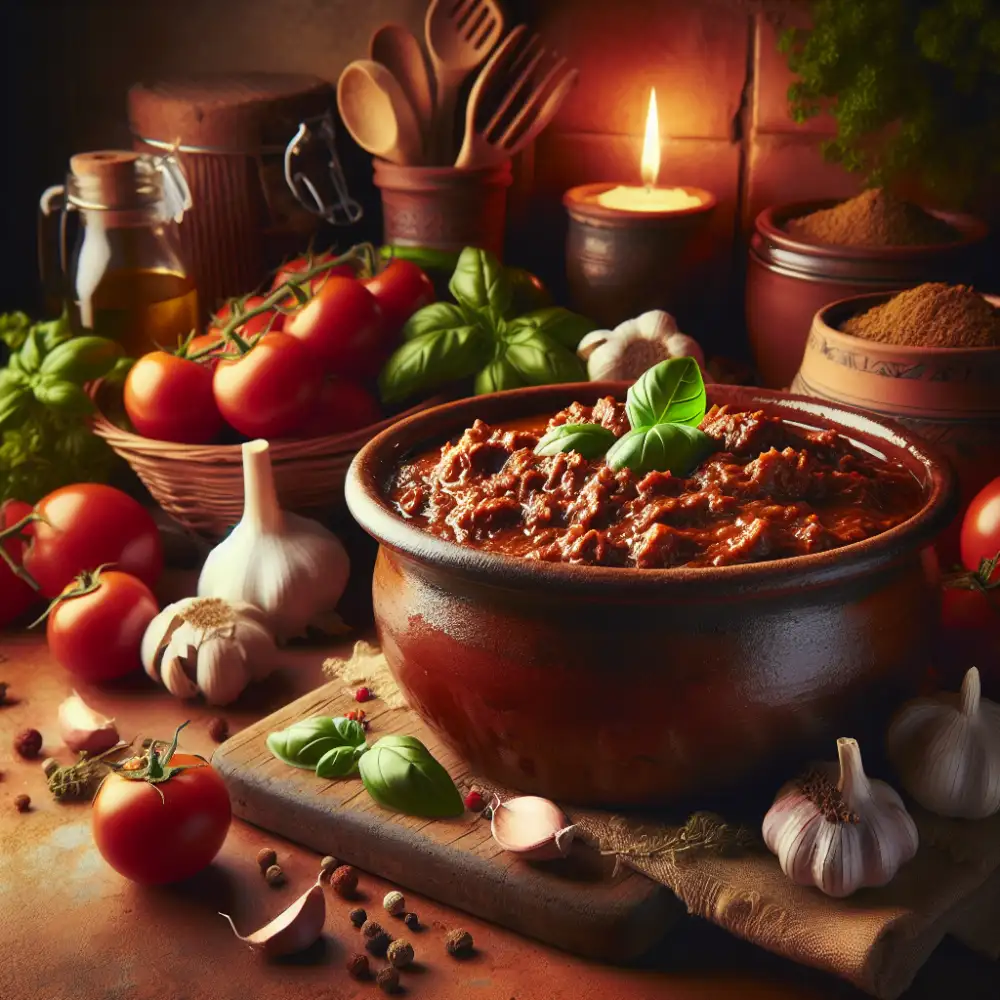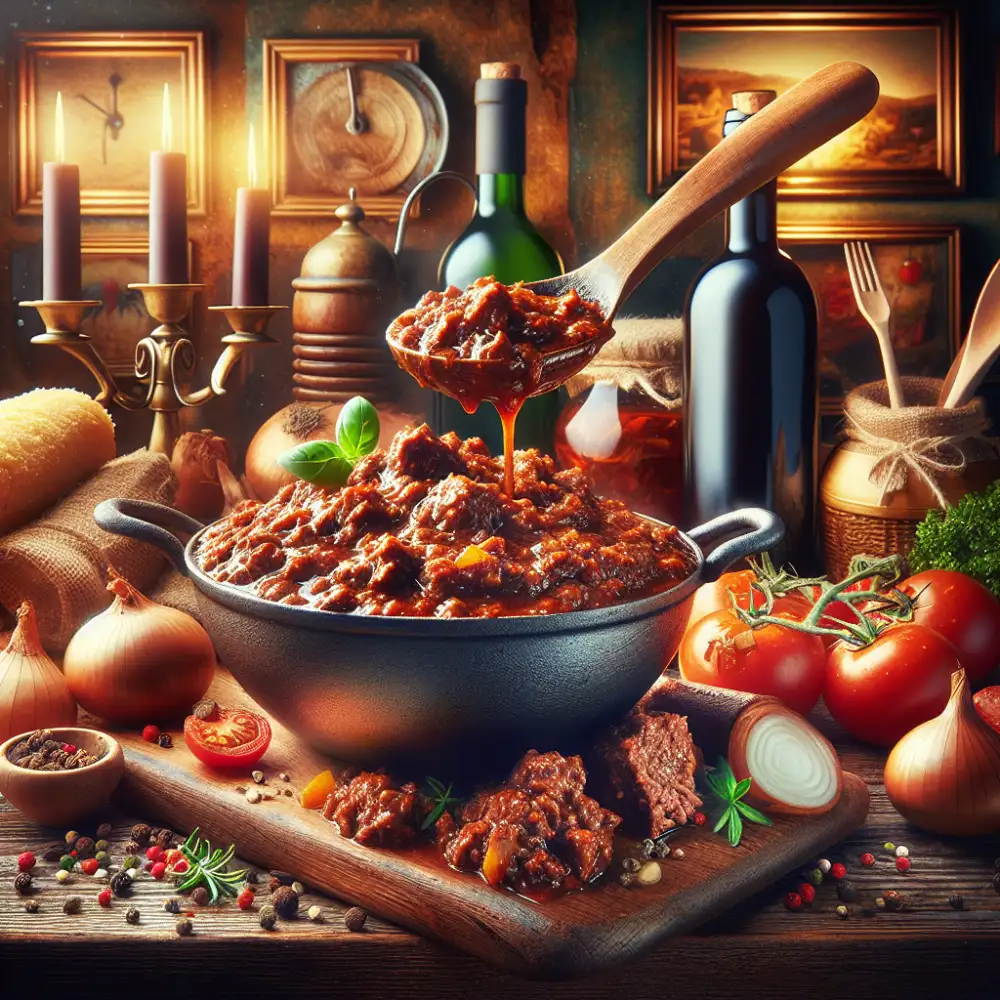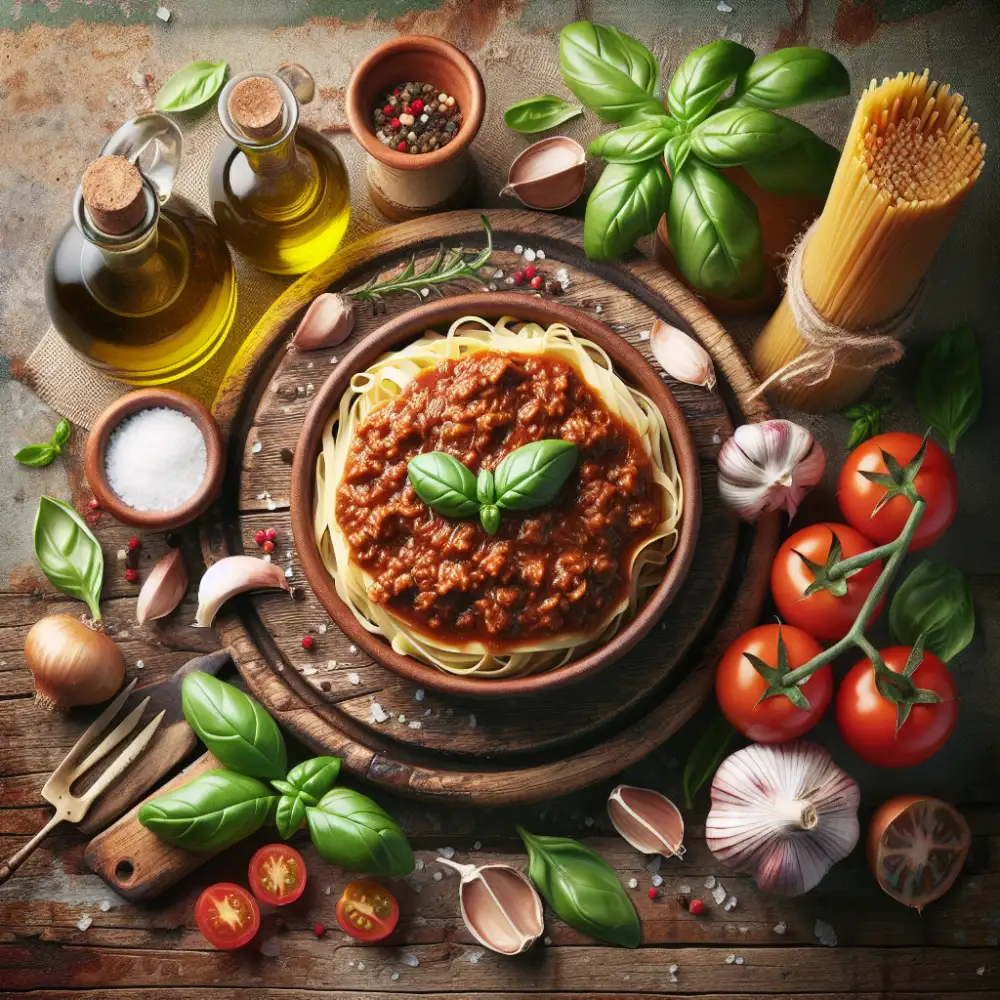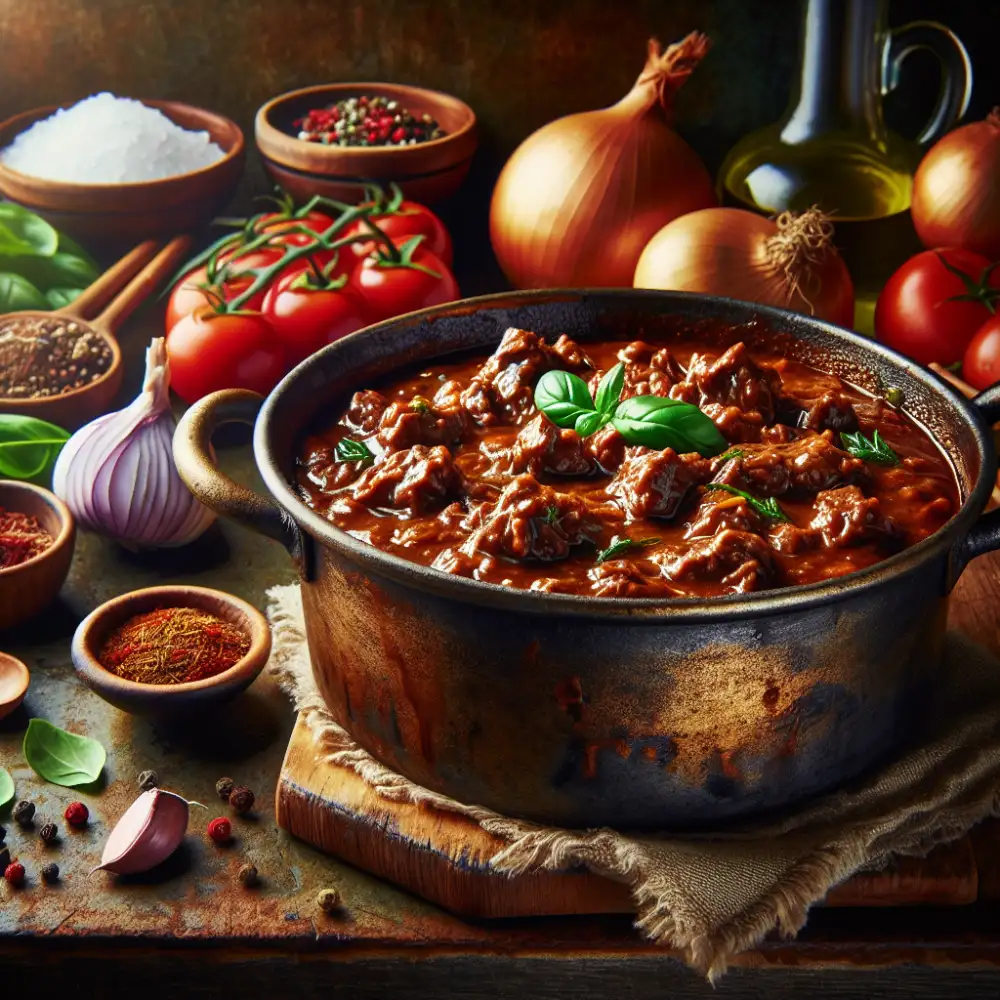Unleash the Flavor: Mastering the Art of Authentic Ragu

Classic Ragu Bolognese
Ragu Bolognese is the king of Italian meat sauces, a dish so iconic it transcends mere cuisine and enters the realm of cultural heritage. This isn't just a sauce to be whipped up; it's a labor of love, a slow and steady simmering process that transforms humble ingredients into a symphony of flavor.
While many variations exist, the heart of a classic Bolognese lies in its simplicity. Ground beef, pancetta, and aromatic vegetables like onion, carrot, and celery form the foundation. These are gently sautéed, coaxing out their inherent sweetness before being bathed in a rich tapestry of tomatoes, red wine, and broth.
The magic, however, unfolds during the long, slow simmer. Hours on the stovetop, or even better, a low and slow braise in the oven, allows the flavors to meld and deepen. The sauce reduces, concentrating its essence, while the meat becomes meltingly tender. A touch of milk, an old-school trick, adds a subtle creaminess and rounds out the richness.
The beauty of Ragu Bolognese lies not only in its taste but also in its versatility. While it's traditionally paired with tagliatelle, its robust flavor complements a variety of pasta shapes, from pappardelle to rigatoni. It can also be used as a base for lasagna or baked pasta dishes, adding depth and complexity to every bite.
Making Ragu Bolognese is a culinary adventure, a journey that rewards patience and attention to detail. It's about embracing the slow food philosophy, understanding that some of life's greatest pleasures, much like this iconic sauce, are best savored slowly.
| Feature | Ragù alla Bolognese | Ragù alla Napoletana |
|---|---|---|
| Main Meat | Beef and Pork | Beef and Pork (optional veal) |
| Tomato Presence | Tomato Paste (small amount) | Whole San Marzano Tomatoes |
| Wine | Red Wine | Red Wine |
| Cooking Time | 2-4 hours (simmered) | 4-6 hours (simmered) |
| Typical Pasta Pairing | Tagliatelle, Pappardelle | Rigatoni, Paccheri, Ziti |
Hearty Ragu Napoletano
Ragu Napoletano is the crown jewel of Neapolitan cuisine. This rich, slow-cooked meat sauce is the heart and soul of many classic Italian dishes, most notably, the Sunday family meal. Unlike its quicker-cooking cousin, Ragu alla Bolognese, Ragu Napoletano is a labor of love, simmered for hours on the stovetop or in a low oven, allowing the flavors to meld and deepen into a symphony of savory goodness.
The foundation of a truly great Ragu Napoletano lies in the quality of its ingredients. We're talking about succulent cuts of beef, preferably with a bit of bone for added richness, and sometimes pork, veal, or even sausage for depth of flavor. San Marzano tomatoes, with their naturally sweet and slightly acidic flavor, are non-negotiable, bringing a vibrant red hue and a taste of the Italian sunshine to the sauce.

The magic, however, unfolds slowly, over low heat. As the meat gently braises in red wine and tomatoes, the kitchen fills with an intoxicating aroma that's impossible to resist. Onions, carrots, and celery, the holy trinity of Italian cooking, add a subtle sweetness and complexity, while a touch of garlic and a sprinkle of peperoncino (chili flakes) provide a hint of spice.
But the true secret to Ragu Napoletano's soul-satisfying flavor lies in the "pipa," a piece of beef or pork bone marrow that simmers patiently with the sauce. This traditional ingredient, often omitted in modern interpretations, imparts an unparalleled richness and depth of flavor that is simply irreplaceable.
Ragu Napoletano is not just a sauce; it's an experience. It's a celebration of slow food, of tradition, and of the simple joy of gathering around a table with loved ones to savor a meal that has been made with love and care. So, the next time you find yourself craving a taste of Italy, take the time to make a pot of Ragu Napoletano. Your taste buds will thank you.
Simple Sausage Ragu
Sausage ragu is a classic Italian meat sauce made with sausage, tomatoes, and wine. It's a hearty and flavorful sauce that's perfect for pasta, polenta, or even just dipping some crusty bread into.
"Ragu" is a general term in Italian cuisine that refers to a meat-based sauce. It can be made with various meats, including beef, pork, veal, and even rabbit or wild boar. The meat is typically slow-cooked in a flavorful liquid, such as wine, broth, or tomatoes, until it's incredibly tender.
While there are countless variations of ragu, they all share a few key ingredients. Tomatoes are essential, providing a base of sweetness and acidity. Wine adds depth of flavor and helps to tenderize the meat. And, of course, no ragu would be complete without a generous amount of herbs and spices.
Sausage ragu is a particularly popular type of ragu, and for good reason. It's relatively quick and easy to make, and the sausage adds a ton of flavor. Italian sausage, either sweet or spicy, is traditional, but you can use any sausage you like.
To make sausage ragu, you'll start by browning the sausage in a large pot or Dutch oven. Once the sausage is cooked through, you'll add the remaining ingredients, including diced tomatoes, red wine, onions, garlic, and herbs like oregano and basil. The sauce is then simmered over low heat for at least an hour, or until the flavors have melded and the sauce has thickened.
Sausage ragu is incredibly versatile and can be used in a variety of dishes. It's most commonly served over pasta, such as pappardelle, tagliatelle, or even just plain old spaghetti. But it's also delicious served with polenta, risotto, or even gnocchi. And if you're feeling really indulgent, you can even use it as a topping for pizza.

No matter how you choose to serve it, sausage ragu is a delicious and satisfying meal that's sure to please everyone at the table. So next time you're looking for a hearty and flavorful meal, give sausage ragu a try. You won't be disappointed.
Flavorful Mushroom Ragu
Mushroom ragu is a delicious and versatile vegetarian alternative to traditional meat-based ragu. While classic Italian ragu often features slow-cooked meats like beef, pork, or veal, mushroom ragu offers a deep, earthy flavor that's just as satisfying. The magic of mushroom ragu lies in its ability to mimic the rich texture and umami depth of its meaty counterpart.
Finely chopped mushrooms, like cremini or portobello, are slowly cooked down with aromatics such as onions, garlic, and herbs. Wine, and sometimes vegetable broth, are added to the mix, creating a luscious sauce as the mushrooms release their natural juices. A touch of tomato paste adds depth and a hint of sweetness, while a sprinkle of dried porcini mushrooms elevates the earthy, savory notes.
The beauty of mushroom ragu is its versatility. It can be tossed with your favorite pasta, like pappardelle or tagliatelle, for a hearty and comforting meal. It also shines as a topping for creamy polenta, baked potatoes, or even as a filling for lasagna or ravioli. The robust flavor of mushroom ragu stands up beautifully to these various applications, making it a true culinary chameleon.
Whether you're vegetarian, looking for a meatless Monday option, or simply craving the comforting flavors of a classic Italian ragu, mushroom ragu is a delicious and satisfying choice.
Versatile Lentil Ragu
Lentil ragu is a delicious and versatile alternative to traditional meat-based sauces. While classic Italian ragu often features slow-cooked meats like beef, pork, or veal, this plant-based version captures the depth of flavor and heartiness of its meaty counterpart. Lentils, with their earthy flavor and satisfying texture, make a wonderful base for a rich and flavorful sauce.
The beauty of lentil ragu lies in its versatility. It can be served with a variety of pasta shapes, from pappardelle to penne to spaghetti. The sauce also pairs well with creamy polenta, creating a comforting and satisfying meal. For a lighter option, serve the ragu over zucchini noodles or spaghetti squash.
One of the key advantages of lentil ragu is its healthfulness. Lentils are an excellent source of plant-based protein and fiber, making them a nutritious and satisfying meal option. They are also low in fat and calories, making them a healthy choice for those watching their weight.
Another advantage of lentil ragu is its affordability. Lentils are a relatively inexpensive ingredient, especially compared to meat. This makes lentil ragu a budget-friendly meal option that doesn't compromise on flavor.


When making lentil ragu, you can customize the flavor profile to your liking. Some popular additions include red wine, diced tomatoes, vegetable broth, and a variety of herbs and spices. For a richer flavor, you can sauté the vegetables in olive oil or add a dollop of tomato paste.
Whether you're a vegetarian, vegan, or simply looking for a delicious and healthy alternative to meat-based sauces, lentil ragu is a versatile and satisfying option. With its rich flavor, hearty texture, and endless possibilities, lentil ragu is sure to become a new favorite in your kitchen.
Serving Ragu: Pasta & More
Ragu, that rich and deeply savory meat sauce, is practically synonymous with Italian cuisine. While it's most famously served with pasta, its versatility extends far beyond just noodles. Let's explore the classic pasta pairings and then venture into the delicious world of "ragu beyond pasta."
Pasta Perfection
The type of pasta you choose for your ragu can significantly influence the overall dining experience. Here are some classic pairings:
Tagliatelle: This long, flat ribbon pasta from Emilia-Romagna, where ragu alla Bolognese originated, is a match made in heaven. Its porous texture clings onto the hearty sauce beautifully.
Pappardelle: Wider than tagliatelle, pappardelle offers even more surface area for the ragu to cling to, making each bite incredibly satisfying.
Rigatoni: These large, ridged tubes are perfect for trapping chunks of meat and sauce, ensuring every mouthful is bursting with flavor.
Gnocchi: These soft, pillowy dumplings offer a delightful textural contrast to the rich ragu.
Beyond the Bowl: Ragu's Versatility
While pasta might be ragu's most famous partner, don't let that limit your culinary creativity. Here are some other delicious ways to enjoy this versatile sauce:
Polenta: Creamy polenta, whether served soft or grilled, provides a blank canvas for the rich flavors of ragu.
Risotto: Stirring a spoonful or two of ragu into your risotto during the final stages of cooking adds depth and complexity.
Vegetables: Roasted or grilled vegetables, like eggplant, zucchini, or bell peppers, take on a whole new dimension of flavor when topped with a generous spoonful of ragu.
Eggs: Elevate your morning eggs by topping them with a spoonful of leftover ragu for a hearty and flavorful breakfast.
Bread: From crusty Italian loaves to toasted baguette slices, bread is the perfect vehicle for soaking up every last drop of delicious ragu.

Whether you're a seasoned chef or a kitchen novice, ragu offers endless possibilities for creating satisfying and flavorful meals. So, the next time you find yourself with a pot of this Italian goodness simmering on the stove, think beyond the pasta bowl and explore the delicious world of ragu's versatility.
Ragu: Tips and Tricks
Ragu is so much more than just a simple meat sauce. It's a celebration of slow cooking, patience, and the magic that happens when simple ingredients simmer together for hours. Whether you're craving a classic Ragu alla Bolognese or want to explore regional variations, a few key tips and tricks can elevate your ragu from good to extraordinary.
First things first, choose the right meat. A mix of ground beef, pork, and veal is traditional for a Bolognese, but feel free to experiment. Ground lamb or even pancetta can add depth of flavor. Browning the meat properly is crucial. Don't rush this step. Cook the meat in batches over medium heat, ensuring it develops a rich, brown crust. This caramelization adds layers of savory complexity to your ragu.
Next up, the soffritto. This aromatic base of finely chopped onions, carrots, and celery is the backbone of flavor in many Italian sauces. Sauté the soffritto gently in olive oil until softened and fragrant, but not browned. This allows the vegetables to release their sweetness and create a harmonious base for the sauce.
Wine is your friend. Deglazing the pan with red or white wine adds another dimension of flavor and helps lift those tasty browned bits from the bottom of the pan. Let the wine reduce slightly before adding the remaining ingredients. Now, for the heart of the ragu: tomatoes. Use high-quality canned whole peeled tomatoes, crushing them by hand or using a food mill. This gives you a smoother texture than diced tomatoes. Simmer, simmer, simmer. Ragu is all about slow cooking. Allow the sauce to simmer uncovered for at least three hours, or even longer, stirring occasionally. This allows the flavors to meld and deepen, resulting in a rich, complex sauce.
Finally, don't forget the finishing touches. A knob of butter stirred in at the end adds a silky texture and enhances the richness of the sauce. Freshly grated Parmesan cheese is a must for serving, adding a salty, umami kick. With these tips and a little patience, you'll be well on your way to creating a ragu that will transport you straight to the heart of Italy.
Published: 21. 06. 2024
Category: Food



